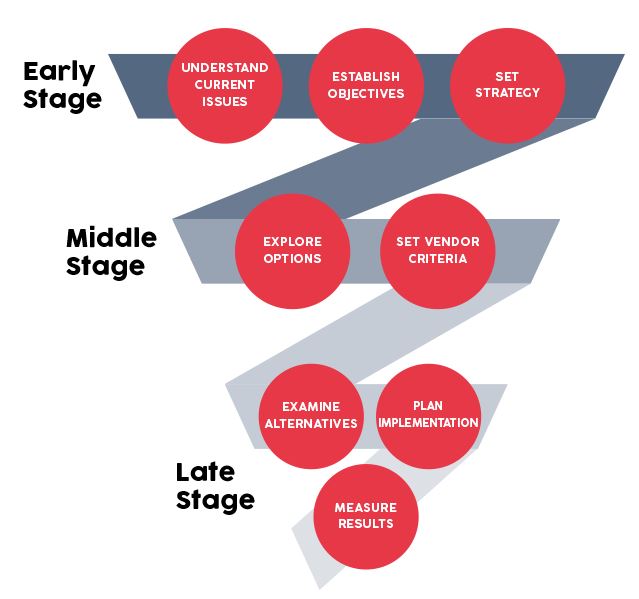The B2B Buyer's Journey: Explained

By Abby Sorensen, Editor
There’s a proven way to win more business that doesn’t involve raising a new round of funding, hiring more sales reps, or implementing new software. No gimmicks, no secrets, no flavor-of-the-month strategy. Ready for it?
You will win more business if you create and properly distribute relevant content that truly helps buyers throughout the entire buyer’s journey.
Here is that revelatory statement again, this time italicized instead of in bold font, in case you glazed over that sentence: You will win more business if you create and properly distribute relevant content that truly helps buyers throughout the entire buyer’s journey.
The most important part of this statement is the phrase “buyer’s journey.” Understanding it is arguably the most critical element of being a successful B2B marketer today. And despite how crucial it is, far too many suppliers miss the mark and confuse the concept with a “seller’s journey.”
Once you understand the buyer’s journey, you can then start to build a content marketing and sales follow-up strategy that helps your prospects and customers navigate it.
The Buyer’s Journey Is NOT The Seller’s Journey
There are many variations of the buying life cycle and its connection to marketing. Be highly skeptical of those that start at the buyer’s first direct connection to the supplier. Too many suppliers want to believe B2B buyer’s journeys are as simple as a three-step Awareness-Consideration-Purchase depiction. That’s how a supplier wants the journey to work, but for buyers, it is much more complicated.
Buyers do a massive amount of up-front work before involving suppliers. In fact, the buying process is coming to a close by the time a buyer requests a demo, agrees to a meeting at a trade show, or schedules a call with your sales team. That means your opportunity to influence the buyer’s decision-making team has long passed. As a result, suppliers are often frustrated by buyers’ predetermined budgets and preconceived opinion of your capabilities.
The problem with traditional marketing activities is that they’re designed to generate more demos, more trade show meets, and/or more sales calls. That strategy won’t help suppliers win more business because it doesn’t increase your amount of influence over the decision-making process.
If you want your sales and marketing efforts to capture a buyer’s attention and influence the decision-making process, you first need to accept a few realities about how B2B buying works:
- The buyer’s journey begins long before there is intent to evaluate a product or service to fill a need.
- Buyers want to remain anonymous to suppliers for as long as possible during the journey.
- B2B purchase decisions are nearing an end by the time buyers interact directly with a supplier. Don’t just take our word for it. Gartner’s research shows that buying groups spend 83 percent of their time doing something other than meeting with potential suppliers.
- Content is one of the best ways to influence a buyer during the beginning of the buyer’s journey when buyers don’t want to be sold by suppliers.
- The “buyer” in a B2B buyer’s journey is not a singular person your sales team needs to win over. Research shows there are an average of 6.8 people involved in a customer buying group in a typical B2B purchase (more on that in our article, “Leads Aren’t Buyers, Why Tracking Companywide Engagement Is Crucial In B2B Marketing”).
The 3 Stages Of The Buyer’s Journey
The concept of a buyer’s journey isn’t new. It’s been researched and written about many times over. One of our favorite interpretations of this is from Selling To The C-Suite by Nicholas Read and Stephen Bistritz. The book explains the buyer’s journey as an eight-step process that takes place in three stages (early, middle, and late).

The early stage of the buyer’s journey typically happens without a supplier’s input. Buyers first seek to (1) understand current issues. Then they (2) establish objectives. Buyers will also (3) set strategy during this early phase.
Supplier content for the early stage of the buyer’s journey can include objective and educational thought leadership articles with no overt vendor branding.
The middle stage of the buyer’s journey is also largely navigated without direct input from a supplier. Buyers (4) explore options. Then they (5) set vendor criteria.
Supplier content for the middle stage of the buyer’s journey can include things like case studies and comparative research and can be lightly branded.
The late stage of the buyer’s journey is where too much of a supplier’s marketing is typically focused. By this point, buyers are (6) examining alternatives. After that, buyers (7) plan implementation. And at the very end, buyers will (8) measure results.
Supplier content for the late stage of the buyer’s journey can include product/service descriptions and application notes and can be heavily branded.
Remember, the buyer’s journey is all about the buyer. It’s not about interrupting or trying to shortcut the process so that you can sell more as a supplier. Your customers and prospects will complete their buyer’s journeys with or without your help. The best way for you to help is to follow along and provide helpful content throughout each stage.
